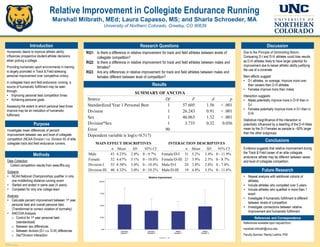Report
Share
Download to read offline

Recommended
More Related Content
Similar to UNC Poster_SRM 700 (16.04.29)
Similar to UNC Poster_SRM 700 (16.04.29) (20)
Body Image Differences in Female Collegiate Athletes

Body Image Differences in Female Collegiate Athletes
A Study of Leadership Behavior Psychological Characteristics Male and Female ...

A Study of Leadership Behavior Psychological Characteristics Male and Female ...
The perceptionofawardwinningathletesontheeffectsofcoachingandpsychologicalbeh...

The perceptionofawardwinningathletesontheeffectsofcoachingandpsychologicalbeh...
(洪千巧)Constraints and motivators a new model to explain sport consumer behav...

(洪千巧)Constraints and motivators a new model to explain sport consumer behav...
Volunteer Youth Sport Coaches Dr. Fletcher MGM Grand 25 July 2012

Volunteer Youth Sport Coaches Dr. Fletcher MGM Grand 25 July 2012
Comparative Study on Physical Fitness of Volleyball and Football Players in U...

Comparative Study on Physical Fitness of Volleyball and Football Players in U...
Comparison of Selected Physical Fitness Components between Bangladeshi and In...

Comparison of Selected Physical Fitness Components between Bangladeshi and In...
THE RELATIONSHIP OF COACHING LEADERSHIP AND ATHLETE SATISFACTION

THE RELATIONSHIP OF COACHING LEADERSHIP AND ATHLETE SATISFACTION
Diferencias en el_coaching_psicologico_de_mujeres_y_hombres

Diferencias en el_coaching_psicologico_de_mujeres_y_hombres
Comparison of Selected Anthropometric and Physical Fitness Variables between ...

Comparison of Selected Anthropometric and Physical Fitness Variables between ...
UNC Poster_SRM 700 (16.04.29)
- 1. POSTER TEMPLATE BY: www.PosterPresentations.com Relative Improvement in Collegiate Endurance Running Marshall Milbrath, MEd; Laura Capasso, MS; and Sharla Schroeder, MA University of Northern Colorado, Greeley, CO 80639 Introduction Discussion References and Correspondence Research Questions Humanistic desire to improve athletic ability influences prospective student-athlete decisions when picking a college. Providing humanistic sport environments in training is largely promoted in Track & Field stressing personal improvement over competitive victory. In collegiate track and field endurance running, a source of humanistic fulfillment may be seen through: • Improving personal best competition times • Achieving personal goals Assessing the extent to which personal best times improve may be an indication of humanistic fulfillment. RQ1: Is there a difference in relative improvement for track and field athletes between levels of collegiate competition? RQ2: Is there a difference in relative improvement for track and field athletes between males and females? RQ3: Are any differences in relative improvement for track and field athletes between males and females different between level of competition? Purpose Investigate mean differences of percent improvement between sex and level of collegiate competition (NCAA Division I v.s. Division III) of elite collegiate track and field endurance runners. Methods Data Collection Collect competition results from www.tffrs.org. Subjects • NCAA National Championships qualifier in only one middle/long distance running event • Started and ended in same year (4 years) • Competed for only one college team Analysis • Calculate percent improvement between 1st year personal best and overall personal best. (Transformed to correct violation of normality) • ANCOVAAnalysis o Control for 1st year personal best (standardized) o Between sex differences o Between division (D-I v.s. D-III) differences o Sex*Division interaction Results Due to the Principle of Diminishing Return, Comparing D-I and D-III athletes could bias results as D-III athletes likely to have larger potential for improvement due to lesser athletic ability justifying the use of a covariate Main effects suggest: • D-I athletes, on average, improve more over their careers than D-III athletes • Females improve more than males Interaction suggests: • Males potentially improve more in D-III than in D-I • Females potentially improve more in D-I than in D-III. Statistical insignificance of the interaction is potentially influenced by a dwarfing of the D-III Male mean by the D-I Females as sample is ~50% larger than the other subgroups. Future Research • Repeat analysis with additional cohorts of athletes. • Include athletes who competed over 5 years • Include athletes who qualified in more than 1 event • Investigate if humanistic fulfillment is different between levels of competition • Investigate connections between relative improvement and humanistic fulfillment SUMMARY OF ANCOVA Source Df F d p Standardized Year 1 Personal Best 1 57.605 1.56 < .001 Division 1 26.243 0.91 < .001 Sex 1 46.063 1.32 < .001 Division*Sex 1 3.735 0.32 0.056 Error 90 Dependent variable is log(x+0.517) MAIN EFFECT DESCRIPTIVES n Mean SD 95% CI Male 43 4.23% 2.8% 0 - 9.7% Female 52 4.67% 3.1% 0 - 10.8% Division I 55 4.58% 3.0% 0 - 10.4% Division III 40 4.32% 3.0% 0 - 10.2% INTERACTION DESCRIPTIVES n Mean SD 95% CI Female/D-I 31 5.2% 3.4% 0 - 11.9% Female/D-III 21 3.9% 2.5% 0 - 8.7% Male/D-I 24 3.8% 2.0% 0 - 7.8% Male/D-III 19 4.8% 3.5% 0 - 11.6% Conclusions Evidence suggests that relative improvement during the Track & Field career of an elite collegiate endurance athlete may be different between sexes and level of collegiate competition. References available upon requestfrom: marshall.milbrath@unco.edu Faculty Sponsor:Randy Larkins, PhD